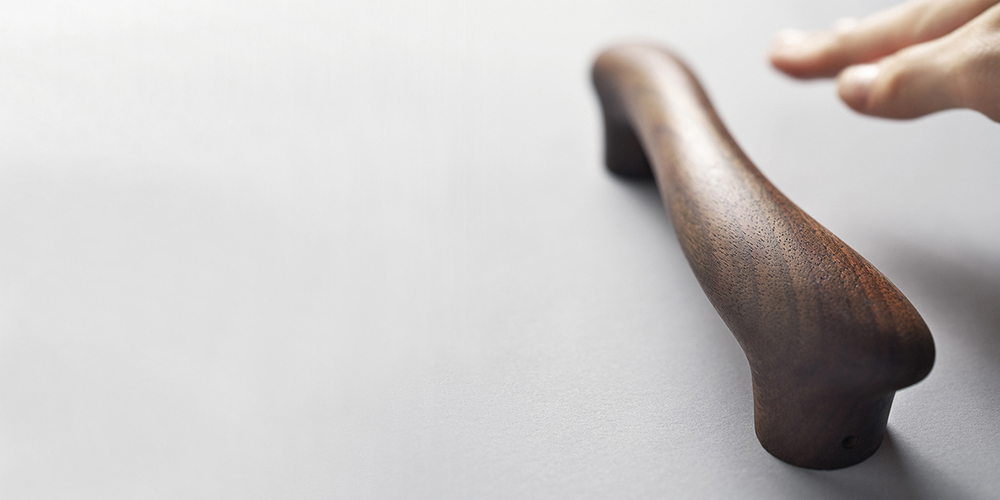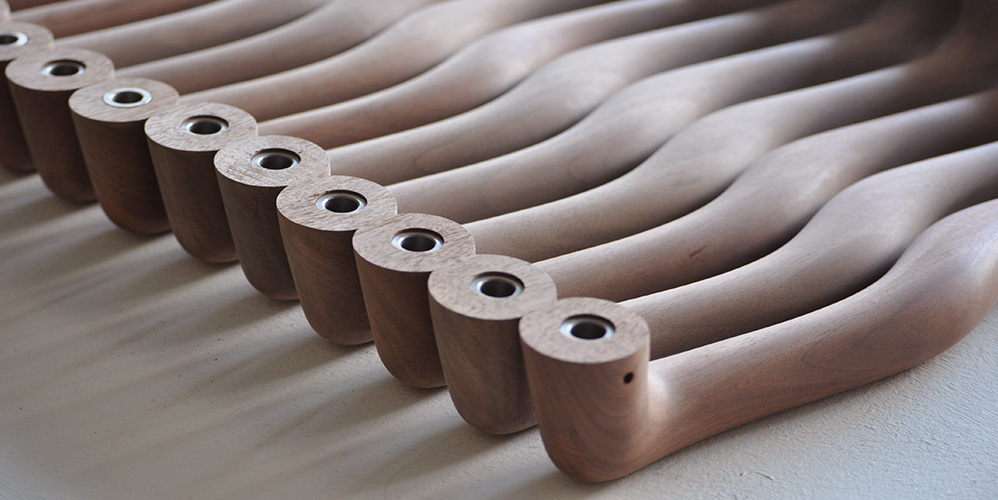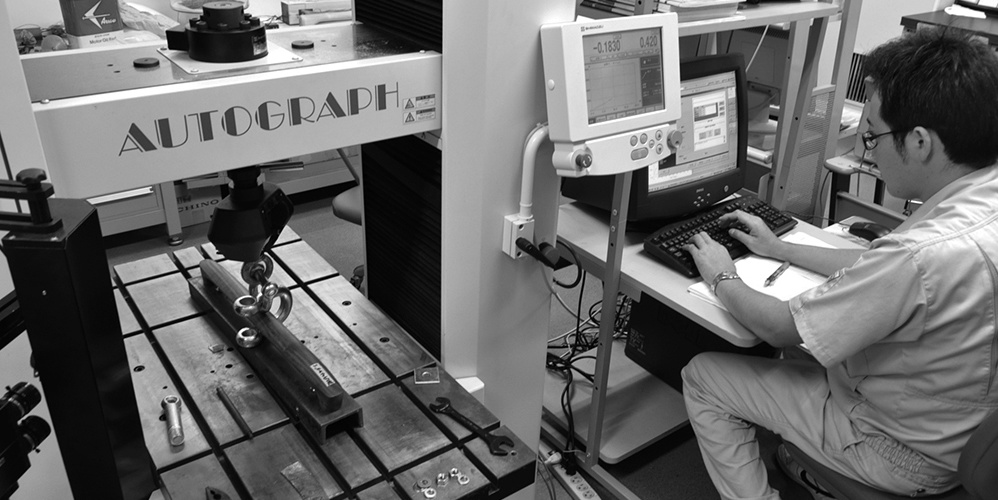
Company name:Sugatakatachi
Office 1365-1 Iwazo, Utsunomiya, Tochigi 321-0973, Japan
Tel& Fax +81-28-662-6934
URL http://www.sugatakatachi.com/EN
Factory Sampaikawagishi, Oyama, Tochigi 323-0015, Japan
Establishment : 20 February 2012
Officer : Representative Director, Makiko Takahashi
|
Door handles as a human interface |
Human beings feel the world through the 5 senses: the sight, the hearing, the touch, the smell and the taste; and they are also able to convey information to others with their voice or body. And all the objects that link mankind to its environment are called 'human interfaces'. These are for example the pedals or the handlebars of a bike, the screen, the keyboard and the mouse of a computer.Yet, these interfaces are not exclusive to the relations between humans with the machines, quite the contrary, they affect all the domains linked to the conception of living spaces. What is clearly noticeable is the common point shared by most of these interfaces: they must be touched to be used.
Most of the traditionnal construction materials: wood, stone, paper, fabric and leather are now replaced by artificial or imitation ones, with an identical look. And this trend of visual reproduction of materials and textures is settled in Japan too. However, in the inside of a room which actually is a human interface, the sense of touch is necessary for someone to feel comfortable, and this very sense is often difficult to satisfy when the only focus of the immitation materials is the sight. In this case, what kind of contact makes you feel comfortable in a space?
We believe that this is due to the natural impression of fluctuation of the material used. And it is indeed important to see this gentle fluctuation while looking at the wood grain, the surface of the rock, the paper or the fabric, but first of all, there is to feel physically the form and the texture. In another hand, it is true that there are surprisingly few places in life spaces where sensations can be felt. What a wide surface may contain are not the walls, neither the floor or the ceilling. If we pay attention to it, the inside of an entrance is filled withmany elements: the door handles, and the furnitures ones, the wall hangers, the chairs, etc. Among these rigid or frail, curved or angular shapes, all possess this irregular movement, this distinctive relief of texture and shape, and it is this very difference that brings the most important comfort in everyday life. This is especially true when it comes to door handles, as it is one of the most manipulated parts in a home.
Additionally, when these handles are integrated to the doors and drawers, a comfortable movement is necessary. And it is important to design this "movement" in the living space by considering the floor, the walls, the ceiling and even the lighting as complementary elements in order to create an aesthetic combination. This rustic style trend is particularly characterised by the impression of simplicity that gives the interior, like the one which remains after the work of a craftsman. It is this style that is probably the closest to the purpose of our handles.
 Sugatakatachi Pepresentative Director Makiko Takahashi |
Giving Shape to Movements Beautiful shapes created in forms of people whose aim is to live with beauty.Making the ordinary actions of users beautiful through the design of shapes. This is the spirit of the SUGATA KATACHI brand name. We are Makiko Takahashi, a creator of fabric products, and Yasufumi Takahashi, a modern artist. We have both worked and studied in Europe and the United States. When we returned home from New York in 2005, we rediscovered the refined movement and manner of the Japanese, as exemplified by gardens, the tea ceremony, and calligraphy. With designs that "give shape to movements", we set out to create objects that are unique, of good quality, and which can be part of your life for many, many years. We'd like to contribute to the creation of beautiful living spaces with the concept of "Shapes Created in Forms of People Whose Aim is to Live with Beauty." View activities of Makiko Takahashi ※ Only Japanese description |
 Yasufumi Takahashi Sculptor / Sugatakatachi Art Director / Maister M.F.A. in Graduate School of THE University of Tsukuba Ecole Nationale superieure des Beaux-Art de Paris Japanese Goverment Overseas Study Programme for Artists / New York Pollock-Krasner Foundation Grant |
After he learned sculpture in Japanese university and in Ecole Nationale superieure des Beaux-Art de Paris, he began work published in Belgium. Since his art work selected permanent collection to the National Quebec Museum of Canada, he held a solo exhibition at North American's gallery, Utsunomiya Museum of Art (2004), such as Shibukawa City Museum (2008). His masterpiece "matrix of space" "Layer work" was highly acclaimed. When he returned home from New York in 2005, he rediscovered the refined movement and manner of the Japanese, as exemplified by gardens, the tea ceremony, and calligraphy. With designs that "give shape to movements". He set out to create objects that are unique, of high quality, and which can be part of your life for many, many years. So he established 'Sugatakatachi' with his wife, Makiko. Since then, he starting working as a product designer. Tokyo International Gift Show (2012), Maison & Objet (Paris 2013 - 2018) Hall 7 "Now", 8 "Projet" ,IFFT Interior Lifestyle Living (Tokyo 2013), exhibited at Ambiente (Frankfurt 2014, 15). Work collection is chosen to Ambiente trend. His door handles have been recognized for their high quality, as exemplified by the fact that they are used in all the rooms of JR kyushu's "Seven Stars in Kyushu" sleeper train, the world's first-class "cruise train." |
|
Our quality |
1. It feels nice!The ergonomic form designed by Yasufumi Takahashi thinking of the movement of the hand grasping the door handle has an asymmetric and smooth three-dimensional curved surface and is comfortable and familiar to the hand.
|
2. The more you use it, the better it gets.The door handle engraved from hardwoods is not hot in the summer, cold in the winter. Thanks to the vegetable oil finish it is easy to maintain and increases the colour and lustre, and the attachment to the extent you use it.
|
3. The installation is easy and reliable.Since it adopts easy and reliable attachment method with precision machined metal fittings, it can be attached to either a wooden, a glass, or a metal door, and can also be fixed as a handrail on a pillar or a wall just by changing screws.
|
4. It is strong!We conducted repeated wear tests 40,000 times with certified machines and confirmed that our handles have sufficient strength to endure both pulling and compression. Because it is made out of natural wood without seams and adhesion, including the legs of the attachment part, they have no weak point: they receive the load by the entire bridge-like handle when applying force.
|
5. You do not receive handles just made a few days before.In order to control its temperature, the possible deformations and discoloration due to humidity change and ultraviolet ray after its installation on door, the finished handle is kept from 1 to 5 years to age like wine and to stabilise. We then check the state of the product (depth of color, lustre, curve, twist, crack), choose the best one, lightly oil it one last time and it is ready to be sent. The selection procees takes time, but enables us to provide you with the best quality handls you could find.
|
All our products are manufacture by hand in Japan by Yasufumi Takahashi, designer and craftsman, and are recognised in Japan and in the world for their quality by our partners : JR Kyushu Cruise Train Nanatsuta, Tokyu The Royal Express Cruise Train, La Mourra 5 stars hotel in France, and so on!
| View Construction Examples ▶︎ |





